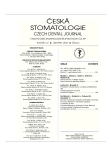Caries Experience in Czech Preschool Children
Authors:
E. Lenčová; Z. Broukal
Authors‘ workplace:
Ústav klinické a experimentální stomatologie 1. LF UK a VFN, Praha
Published in:
Česká stomatologie / Praktické zubní lékařství, ročník 112, 2012, 6, s. 168-172
Category:
Original Article – Epidemiological Study
Věnováno prof. MUDr. Janě Duškové, DrSc., MBA, k významnému životnímu jubileu
Overview
Introduction, Aim: Childhood caries is the most common chronic childhood disease. The Czech Republic still belongs to countries with relatively high caries prevalence. The aim of the cross-sectional survey was to evaluate caries prevalence in the primary dentition of Czech preschoolers aged 3–6 years.
Methods:
The study design was approved by the competent Local Ethics Committee. The study was realized in 44 geographically stratified sites. The study sample consisted of preschool children aged 3-6 years, who were included in the study based on signed informed consent of their legal representatives. Epidemiologic examination of the subjects was performed in compliance with the WHO requirements for national oral health surveys including calibration exercise. A caries detection threshold used was a cavitated carious lesion. From dental records, the following oral health indicators were calculated: mean dmft per one child; mean dt; proportion of caries-free children; restorative index (ri) and significant caries index (SiC).
Results:
The study included 1232 children with a mean age 5.1 yrs (SD 0.81 yrs). Values of the above indicators: mean dmft: 2.55 (95% CI 2.22–2.66); mean dt: 1.87 (95% CI 1.62–2.00); proportion of caries-free children: 50.9%; ri: 21%; SiC: 6.9 (95% CI 6.60–7.25).
Conclusions:
Approximately half of the sample was caries-free. The SiC value was almost threetimes higher than mean dmft per child. Only one fifth of the teeth affected with dental caries were adequately treated. Further reduction of caries prevalence in the Czech preschool population cannot be expected without adequate caries-preventive interventions. Thus, oral health surveillance should be executed by regulatory authorities to help the policymakers get support for preventive initiatives and to enable further monitoring of childhood caries.
Key words:
caries experience – primary dentition – cross-sectional oral health study – significant caries index
Sources
1. Benzian, H., Monse, B., Heinrich-Weltzien, R., Hobdell, M., Mulder, J., van Palenstein Helderman, W.: Untreated severe dental decay: a neglected determinant of low Body Mass Index in 12-year-old Filipino children. BMC Public Health, roč. 11, 2011, s. 558.
2. Casamassimo, P. S., Thikkurissy, S., Edelstein, B. L., Maiorini, E.: Beyond the dmft: the human and economic cost of early childhood caries. J. Am. Dent. Assoc., roč. 140, 2009, č. 6, s. 650–657.
3. Gao, X. L., Hsu, C. Y., Xu, Y., Hwarng, H. B., Loh, T., Koh, D.: Building caries risk assessment models for children. J. Dent. Res., roč. 89, 2010, č. 6, s. 637–643.
4. Haugejorden, O., Birkeland, J. M.: Evidence for reversal of the caries decline among Norwegian children. Int. J. Paediatr. Dent., roč. 12, 2002, č. 5, s. 306–315.
5. HEALTH 21: an introduction to the health for all policy framework for the WHO European Region. Copenhagen: WHO Regional Office for Europe, 1998.
6. Ismail, A. I., Sohn, W., Tellez, M., Amaya, A., Sen, A., Hasson, H., Pitts, N. B.: The International Caries Detection and Assessment System (ICDAS): an integrated system for measuring dental caries. Community Dent. Oral Epidemiol., roč. 35, 2007, č. 3, s. 170–178.
7. Kagihara, L. E., Niederhauser, V. P., Stark, M.: Assessment, management, and prevention of early childhood caries. J. Am. Acad. Nurse Pract., roč. 21, 2009, č. 1, s. 1–10.
8. Marthaler, T. M.: Changes in dental caries 1953–2003. Caries Res., roč. 38, 2004, č. 3, s. 173–181.
9. Namal, N., Yuceokur, A. A., Can, G.: Significant caries index values and related factors in 5-6-year-old children in Istanbul, Turkey. East Mediterr. Health J., roč. 15, 2009, č. 1, s. 178–184.
10. Oral health surveys. Basic methods., 4th ed. Geneva: World Health Organization; 1997.
11. Pitts, N. B., Chestnutt, I. G., Evans, D., White, D., Chadwick, B., Steele, J. G.: The dentinal caries experience of children in the United Kingdom. Br. Dent. J., roč. 200, 2006, č. 6, s. 313–320.
12. Policy on early childhood caries (ECC): classifications, consequences, and preventive strategies. Pediatr. Dent., roč. 30, 2008–2009, č. 7 (Suppl.), s. 40–43.
13. Speechley, M., Johnston, D. W.: Some evidence from Ontario, Canada, of a reversal in the dental caries decline. Caries Res., roč. 30, 1996, č. 6, 423–427.
14. Výběr z Rejstříku škol a školských zařízení [online], [cit. 2012-06-01]. Dostupný z: [http://rejskol.msmt.cz]
Labels
Maxillofacial surgery Orthodontics Dental medicineArticle was published in
Czech Dental Journal

2012 Issue 6
- What Effect Can Be Expected from Limosilactobacillus reuteri in Mucositis and Peri-Implantitis?
- The Importance of Limosilactobacillus reuteri in Administration to Diabetics with Gingivitis
Most read in this issue
- Rare Tumours in Maxillary Region
- Caries Experience in Czech Preschool Children
- Risk Factors of Dental Caries Development in One-Year Old Infants
- Nanotechnology in Dentistry
